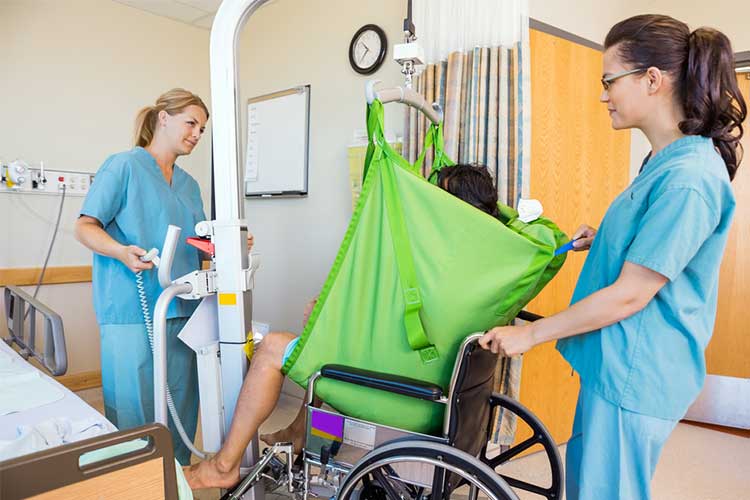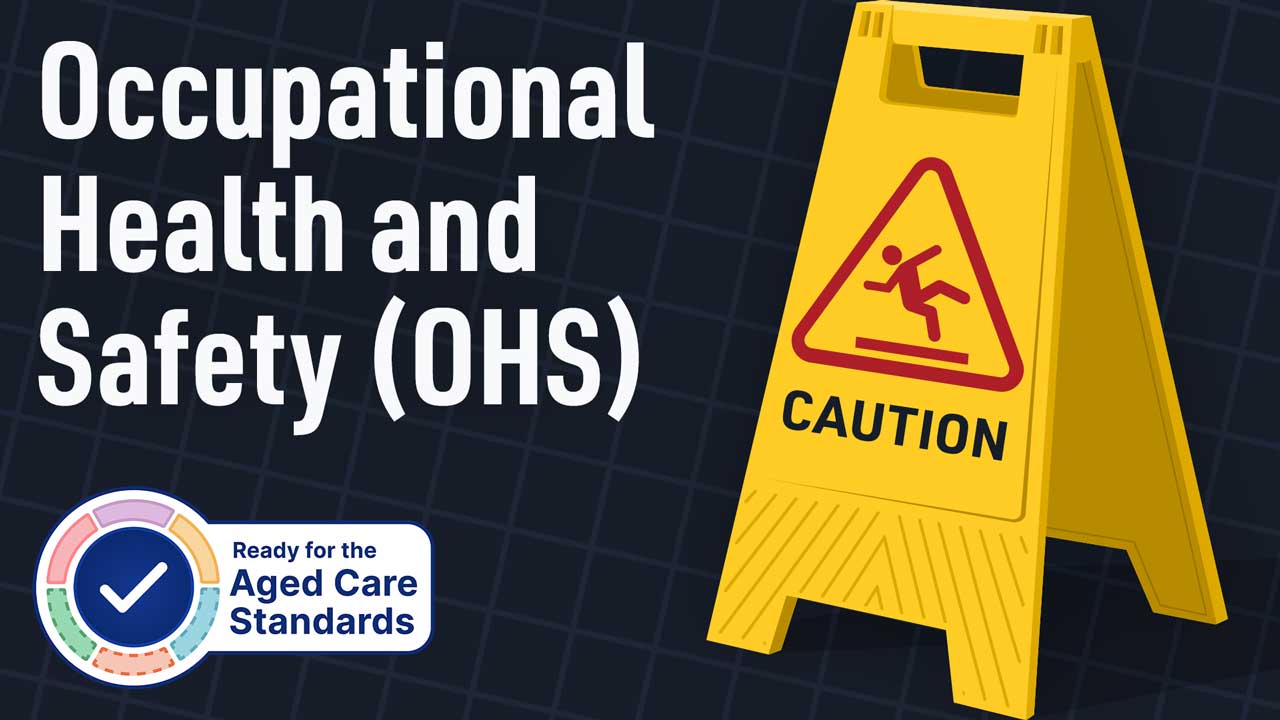- 195 is the number of Australians killed at work in 2022.
- 127,800 is the number of serious workers’ compensation claims made in 2021-2022.
- 497,300 is the total number of people who experienced work-related injury or illness in 2021-2022.
(Safe Work Australia 2023; ABS 2023)
Note: Occupational health and safety regulations vary from state to state. It's vital to be aware of the OHS regulations of your state, which can be accessed here.

Why is Occupational Health and Safety a Healthcare Concern?
Workplace injury rates are particularly high in the healthcare sector compared to other industries.
In fact, in 2021-2022:
- Healthcare and social assistance had the highest number of serious workers’ compensation claims made among all industries (18.9% of all serious claims)
- Community and personal service workers had the second highest number of serious workers’ compensation claims made among all occupations (21.7% of all serious claims).
(Safe Work Australia 2023)
In Victoria alone:
- The rate of work-related musculoskeletal disorders in healthcare is 71.2%, compared to 54.8% across other industries
- The rate of work-related back injuries is 31.8%, compared to 22% across other industries
- The rate of workplace manual handling-related injuries is 58.9%, compared to 43.9% across other industries.
(WorkSafe Victoria 2007)
Why is this?
Healthcare is inherently associated with a variety of OHS risks, including:
- Exposure to infections such as tuberculosis, hepatitis B and C, COVID-19, influenza and HIV/AIDS
- Manual handling (lifting, transferring, repositioning and moving patients)
- Exposure to hazardous chemicals (e.g. cleaning products, anaesthetic gases, medicines)
- Exposure to radiation when performing medical imaging
- Stress, burnout, fatigue and moral injury caused by pressure, shift work, long working hours etc., especially in light of the COVID-19 pandemic
- High levels of abuse, bullying and harassment in the workplace
- Thermal discomfort (e.g. caused by prolonged work wearing PPE), noise and poor lighting
- Slips, trips and falls
- Road injuries (e.g. ambulance crashes)
- Exposure to environmental hazards such as biological material and clinical waste.
(WHO 2022; Leo et al. 2021; ACN 2021)
Occupational Health and Safety Under the Strengthened Aged Care Quality Standards
Standard 2: The Organisation - Outcome 2.2: Quality and safety culture (Action 2.2.2) of the strengthened Aged Care Quality Standards requires an aged care organisation’s governing body to prioritise their staff's safety, health and wellbeing (ACQSC 2024a).
Additionally, Outcome 2.4: Risk management (Action 2.4.1) states that providers must implement a risk management system to recognise, document, address and monitor risks to their staff (ACQSC 2024b).
Manual Handling
Examples of OHS hazards related to manual handling include:
- Awkward/uncomfortable postures and pressure associated with supporting and assisting a patient to learn to stand and walk
- Awkward/uncomfortable bending and twisting to perform hands-on mobilising treatments (exercises); making and fitting orthoses and artificial limbs; and treating patients’ feet/hands
- Awkward/uncomfortable postures and high-pressure working in confined spaces to assist toileting and/or showering
- Bending, twisting, pushing and pulling to use treatment equipment in small cubicles
- Assisting patients to practise independence and outside skills in an outdoor environment.
(WorkSafe Victoria 2007)
The following strategies can help to decrease the risk of injury in the process of carrying out manual handling tasks:
- Reducing the size and/or weight of objects where possible
- Eliminating bending or reaching by storing objects at waist height
- Eliminating clutter
- Maintaining floor surfaces with good slip resistance
- Using adjustable-height trolleys to move objects
- Attaching lockable castors to objects with wheels
- Providing step platforms and handrails where necessary
- Placing equipment on firm non-slip surfaces
- Identifying weight and size instructions before moving objects.
(WorkSafe Victoria 2021)
Tasks that include lifting, supporting or moving patients or heavy objects, bending, twisting or reaching (e.g. patient transfer, pushing a wheelchair) should be eliminated or minimised where possible (e.g. by using assistive devices) (WorkSafe Victoria 2021).

How Can We Plan for a Safer Workplace?
People handling tasks continue to be a major cause of injury to healthcare staff. The manual lifting of patients should be eliminated, except in emergency situations.
A revised system should include:
- A ‘no lifting’ policy
- The provision of patient handling equipment such as hoists and trolleys, which are appropriate and sufficient in number
- Provision of training to staff in the system of work, including assessing patients’ needs, specific handling techniques and the use of patient-handling equipment
- Monitoring of the ‘no lifting’ system.
(WorkSafe Victoria 2007)
Stress
Stress is an issue present in many workplaces, but healthcare workers must navigate additional challenges such as upset or volatile patients, irregular schedules and high-pressure situations.
Workplace factors that may contribute to stress in healthcare professionals include:
- Dealing with life-threatening illnesses and injuries
- Exposure to suffering and death
- Pressure from employers, patients and patients' family members
- Working in an environment where there is exposure to various hazards, such as infection
- Demanding physical work and risk of injury
- Long and/or irregular work
- Unstable and unpredictable work life
(NIOSH 2023)
These factors may be mitigated by:
- Ensuring staff roles are clearly defined
- Providing staff with the resources, information and training they need to work safely
- Reviewing staff workloads and time pressures
- Regularly checking in with staff to see how they are doing, finding out if anything is causing them stress and addressing these sources of stress
- Supporting staff who are identified as being at risk of workplace psychological injury
- Providing staff with a point of contact to discuss their concerns
- Referring staff to mental health and wellbeing support services, including employee assistance programs.
(Safe Work Australia 2021a)
For your own wellbeing, monitor signs of stress and/or burnout such as affected sleep, increased dependence on alcohol, drugs and/or tobacco and behavioural changes.

Violence, Aggression, Harassment and Bullying
Sadly, violent incidents are more likely to occur around staff who are directly involved in client care, namely nurses, emergency room staff and paramedics.
Violence, aggression, harassment and bullying can cause both physical and psychological harm, making it a risk to the health and safety of staff (Safe Work Australia 2021ab).
The following are some control measures that can be put in place to reduce the risk of harm from violence, aggression, harassment and bullying:
- Avoiding letting staff work alone, where possible
- Providing staff with training on how to manage difficult or aggressive clients and visitors
- Ensuring staff know when to escalate issues to senior staff and are familiar with incident reporting procedures
- Ensuring staff who are working alone have access to communication devices such as pagers or mobile phones so that they can contact someone for help if they are in an unsafe situation
- Ensuring the workplace culture is positive and respectful
- Upholding a zero-tolerance policy for violence, aggression, harassment and bullying.
(Safe Work Australia 2021a)

Risk Assessment and Management
Risk assessment involves identifying potentially dangerous actions and situations. The purpose of risk assessment is to determine:
- How severe a risk is
- Whether any existing control measures are effective
- What action can be taken to manage the risk
- How urgently this action should be taken.
(Safe Work Australia 2022)
For a comprehensive guide on how to perform risk assessment and management, see Risk Assessment and Management in the Home.
Conclusion
Every person has the right to return home from work without injury, and should not have to fear for their own mental and physical wellbeing simply because of their line of work. The expectation and association of danger in healthcare settings only delay the implementation of procedures that could eliminate risk.
Remember that there are behaviours you can implement as an individual to decrease your risk of experiencing harm. Always speak up if you feel that your safety or the safety of a co-worker is being compromised by your work environment.
Test Your Knowledge
Question 1 of 3
Which one of the following is a simple safety precaution you can take as an individual?
Topics
Further your knowledge
References
- Aged Care Quality and Safety Commission 2024, Standard 2: The Organisation, Australian Government, viewed 12 April 2024, https://www.health.gov.au/resources/publications/strengthened-aged-care-quality-standards-august-2025?language=en
- Australian Bureau of Statistics 2023, Work-related Injuries, Australian Government, viewed 12 April 2024, https://www.abs.gov.au/statistics/labour/earnings-and-working-conditions/work-related-injuries/latest-release
- Australian College of Nursing 2021, Bullying in the Workplace, ACN, viewed 12 April 2024, https://www.acn.edu.au/wp-content/uploads/position-statement-bullying-in-the-workplace.pdf
- Leo, CG et al. 2021, ‘Burnout Among Healthcare Workers in the COVID 19 Era: A Review of the Existing Literature’, Frontiers in Public Health, viewed 12 April 2024, https://www.frontiersin.org/articles/10.3389/fpubh.2021.750529/full
- Morphet, J, Griffiths, D, Plummer, V, Innes, K, Fairhall, R & Beattie, J 2014, 'At the Crossroads of Violence and Aggression in the Emergency Department: Perspectives of Australian Emergency Nurses', Australian Health Review, vol. 38, no. 2, pp. 194-201, https://www.publish.csiro.au/ah/AH13189
- The National Institute for Occupational Safety and Health 2023, Healthcare Workers and Work Stress, U.S. Department of Health & Human Services, viewed 12 April 2024, https://www.cdc.gov/niosh/topics/healthcare/workstress.html
- Safe Work Australia 2021b, Bullying, Australian Government, viewed 12 April 2024, https://www.safeworkaustralia.gov.au/safety-topic/hazards/bullying
- Safe Work Australia 2021a, Health Care and Social Assistance: Managing Risks, Australian Government, viewed 12 April 2024, https://www.safeworkaustralia.gov.au/safety-topic/industry-and-business/health-care-and-social-assistance/managing-risks
- Safe Work Australia 2022, Identify, Assess and Control Hazards: Managing Risks, Australian Government, viewed 12 April 2024, https://www.safeworkaustralia.gov.au/safety-topic/managing-health-and-safety/identify-assess-and-control-hazards/managing-risks
- Safe Work Australia 2023, Key Work Health and Safety Statistics Australia, 2023, Australian Government, viewed 12 April 2024, https://data.safeworkaustralia.gov.au/insights/key-whs-stats-2023
- WorkSafe Victoria 2007, A Guide to Designing Workplaces for Safer Handling of People, Victoria State Government, viewed 12 April 2024, https://content.api.worksafe.vic.gov.au/sites/default/files/2018-06/ISBN-Designing-workplaces-for-safer-handling-of-people-guide-2007-09.pdf
- WorkSafe Victoria 2021, Moving or Lifting Objects, Victoria State Government, viewed 12 April 2024, https://www.worksafe.vic.gov.au/moving-or-lifting-objects
- World Health Organisation 2022, Occupational Hazards in the Health Sector, WHO, viewed 12 April 2024, https://www.who.int/tools/occupational-hazards-in-health-sector
 New
New 

